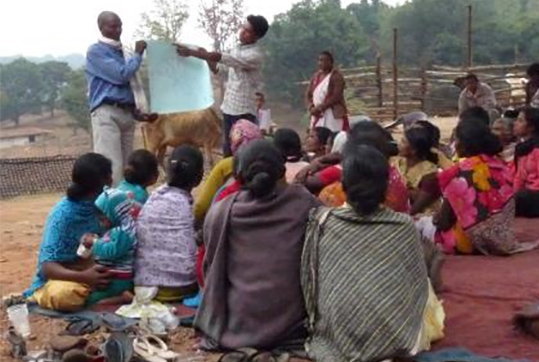
While ‘Development’ signifies a right to advance and progress for some, it also equally carries risks to human life, livelihood, security and dignity, for others. To deserve a positive connotation that reflects holistic, integrated and necessary advancement for society, at large, the focus must be on what constitutes ‘development’ and crucially, against what trade-offs.
The Panchayati Raj Institution (PRI) endorses the idea of self-sufficient and self-governing village communities through a three-tier system in the state with elected bodies at the Village/ Gram, Taluk and District/ Zila levels.
To enable effective implementation of this, several sangathans linked to the SRUTI Fellowships work with the community on village development planning.
The aim is to collectively identify the priorities and participate in decision making with the gram sabha/ gram panchayat at the on what development is required and how available funds are to be utilized. Keeping people’s needs at the core of this exercise, Fellows across Chhattisgarh and Odisha, have held training sessions to formulate a comprehensive plan through Panchayati Raj system to achieve entitlements of health, livelihood, agriculture and education, and also to improve various village amenities.
{village development planning: community knows best}
In Odisha’s Rayagada district, the Lok Chethna Sangathan has motivated more members of the village community to be a part of the village development plans. The microplans covered the geographical location of the village and recorded information regarding it including demarcation of different kinds of land (agricultural, forest, dry), water sources and homes; village history; social structure; ancestry; natural resources; agricultural output, forest and other produce of the village; its external requirements; traditional livelihood and tools, etc. These are meticulously documented with the participation of every family with village elders playing an important role in piecing together the community’s legacy and origins.
The document also elaborates on the symbiotic socio-economic and cultural relationship shared by the villagers and nature. The sangathan plans to prepare a total of 15 village plans for the entire year. This process also integrates the leveraging of Panchayati Raj institution which when effectively used can play a crucial role in ensuring people’s participation and their rightful representation in local governance and development. Significantly, village development plans also focus on and ensure community management and thoughtful useof limited natural resources.
{community forest rights: gadchiroli & niyamgiri lead the way}
Being the original inhabitants, Adivasi communities have long shared a symbiotic relationship with nature. Recognising this relationship, the Government passed the historic Forest Rights Act in 2006 where for the first time a law gives the community the right to protect, manage and conserve forest resources. Colonial forest laws before this criminalized forest dwelling communities and destroyed traditional democratic systems of forest conservation. Two recent far-reaching victories – rights over bamboo in Maharashtra’s Mendha Lekha and people’s rejection of bauxite mining in Niyamgiri, Odisha – asserted the power of the gram sabha and clarified that community consent cannot be undermined.

